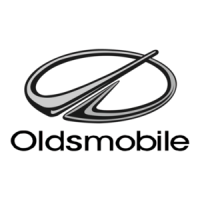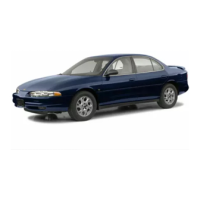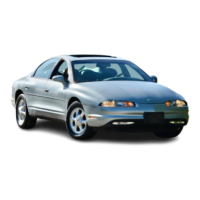
Do you have a question about the Oldsmobile 1998 Intrigue and is the answer not in the manual?
| Brand | Oldsmobile |
|---|---|
| Model | 1998 Intrigue |
| Category | Automobile |
| Language | English |
Information on using seats and safety belts properly, and the SRS system.
How to start, operate, and understand the vehicle's features and controls.
Operating ventilation, comfort controls, and the audio system.
Tips for driving under various conditions and on different types of roads.
What to do if you encounter problems while driving, such as a flat tire.
Instructions on how to maintain the vehicle's proper running condition and appearance.
Information on when to perform scheduled vehicle maintenance services.
How to contact Oldsmobile for assistance and obtain service publications.
How to adjust seats, including reclining seatbacks, folding rear seats, and head restraints.
Guidance on proper safety belt usage and what not to do with airbags and belts.
Instructions for adults on wearing lap-shoulder belts correctly for maximum protection.
Proper safety belt usage for pregnant women, emphasizing lap belt placement.
How the right front passenger's safety belt works and engages the child restraint feature.
Explanation of the SRS or air bag system, including types and operation.
Information about the vehicle's keys, including master keys and spare keys.
How to lock and unlock vehicle doors using keys, transmitters, or power lock switches.
Feature to prevent passengers from opening rear doors from inside the vehicle.
How to customize automatic door locking and unlocking features.
Feature preventing door lock-out when the key is in the ignition with a door open.
Allows doors to lock automatically after passengers exit.
Operation of the remote keyless entry transmitter for locking/unlocking doors and trunk.
Information on trunk lock, remote trunk release, and precautions for driving with an open trunk.
Theft-deterrent features like Passlock® and advice for parking to prevent theft.
Guidelines for breaking in a new vehicle to ensure better long-term performance.
Explanation of the four ignition switch positions: OFF, ACC, ON, and START.
Proper procedure for starting the engine, including tips for flooded engines.
Benefits and usage of the engine coolant heater in cold weather for easier starting.
Explanation of the automatic transaxle shift lever positions and their functions.
Steps to ensure the vehicle is safely secured in PARK, especially on hills.
Precautions and procedures for leaving a vehicle with the engine running.
Warning against parking over flammable materials due to hot exhaust parts.
Information on engine exhaust hazards, carbon monoxide, and signs of exhaust leaks.
Operation of power windows, including the driver's auto-down feature and window lock.
How to adjust the steering wheel for driving comfort and easier entry/exit.
Controls for turn signals, lane changes, and headlamp beam selection.
Operation of windshield wipers, including speed settings and clearing ice/snow.
How to operate the windshield washer fluid spray and precautions in freezing weather.
How to set, use, and end cruise control, with safety warnings for various conditions.
Controls for headlamps, taillamps, parking lamps, license, and sidemarker lamps.
How DRLs improve visibility and the automatic headlamp control function.
Controls for interior lighting, including courtesy lamps and instrument panel brightness.
Adjusting mirrors for clear visibility. Includes inside rearview and electrochromic options.
Controls for adjusting side mirrors, including auto-down feature for driver's window.
Locations for storing items, including the glove box.
Operation of the power sunroof, including express-open and vent features.
Overview of instrument panel components that provide vehicle information.
Explanation of warning lights and gauges that signal vehicle status or potential problems.
Alerts occupants to fasten safety belts with a chime and light.
Indicates the status of the air bag system, warning of malfunctions.
Alerts to potential problems with the charging system or drive belt.
Indicates a problem with the vehicle's hydraulic brake system.
Warns of issues with the anti-lock brake system.
Indicates the Enhanced Traction System is limiting wheel spin or has a problem.
Illuminates when ABS or Enhanced Traction System is active, indicating slippery conditions.
Displays engine coolant temperature; red area indicates overheating.
Alerts if the coolant level is low, indicating potential engine overheating.
Signals a problem detected by the engine's computer regarding fuel, ignition, or emission systems.
Indicates low oil pressure or other oil-related problems requiring immediate attention.
Warns when the engine oil level is low and needs checking.
Indicates the status of the Passlock® theft-deterrent system.
Alerts when the windshield washer fluid level is low.
Indicates when the engine oil life monitor suggests an oil change.
Shows the amount of fuel remaining in the tank when the ignition is on.
Illuminates when the fuel level in the tank is low.
Indicates potential issues affecting vehicle performance or durability.
Controls for heating, cooling, and ventilation system. Best used with windows closed.
System for controlling temperature and airflow. Features electronic controls for various modes.
Provides warm air to the floor ducts using outside air, with engine coolant heater option.
Directs outside air through the vehicle for mild temperatures, includes flow-through system.
Two settings to clear front and side windows; DEFROST for quick clearing, DEFOG for warming.
Sets desired temperature; system automatically adjusts airflow or can be manually controlled.
Left knob sets system temperature. Turn red for warmer, blue for cooler air.
Manually selects fan speed. Airflow may seem low; check filter if needed.
Activates the air conditioning compressor. Indicator light glows when pressed.
Controls airflow direction when not in AUTO. Cycles through upper, BI-LEVEL, FLOOR, DEFOG.
Controls for radio, cassette player, and tone settings. Includes seek and scan functions.
How to switch between AM/FM bands, tune stations, and use seek/scan features.
Five numbered buttons for storing and recalling favorite radio stations.
Adjusts bass and treble, or selects preset equalization settings for different music types.
Controls for balancing sound between left/right (BAL) and front/rear (FADE) speakers.
Instructions for inserting, playing, and controlling cassette tapes. Includes error codes.
Controls for radio, cassette, and CD player. Note on Bose system differences.
Instructions for inserting, playing, and controlling compact discs. Includes error codes.
System designed to discourage radio theft using a secret code.
Buttons on the steering wheel to control radio functions like volume, seek, and program.
Explains factors affecting AM and FM radio reception, including interference and range.
Advice on preventing hearing damage from loud noise and adjusting volume safely.
Maintenance guidelines for cassette player to ensure sound quality and prevent damage.
How to clean glass surfaces, avoiding scratches and protecting the defogger grid.
Best practices for washing the vehicle to preserve its finish, avoiding harsh chemicals.
Advice on waxing and polishing to maintain the paint finish, with warnings about aggressive methods.
Essential advice for safe driving, emphasizing preparedness and anticipating others' actions.
Discusses the dangers of alcohol and driving, its effects, and legal limits.
Explains the three systems controlling the vehicle: brakes, steering, and accelerator.
Details perception and reaction time, stopping distances, and factors affecting them.
Explains the ABS system, its function in preventing skids, and normal operational sounds.
System that limits wheel spin, especially useful in slippery conditions.
How to steer and brake simultaneously during emergencies for better control.
Information on power steering, magnetic speed-sensitive steering, and driving tips.
Guidance on how to safely recover the vehicle if it drives off the road onto the shoulder.
Tips for safely passing other vehicles on two-lane highways, emphasizing caution.
Explains how loss of control occurs due to insufficient tire friction and emergency maneuvers.
Discusses types of skids (braking, steering, acceleration) and how to handle them.
Tips for safer night driving, including defensive driving and adjusting mirrors.
Advice on driving in wet conditions, noting reduced traction and the importance of visibility.
Explains hydroplaning, its causes (water, tire condition, speed), and how to avoid it.
Tips for navigating city streets safely, focusing on traffic awareness and signal observation.
Rules and advice for safe freeway driving, including merging and lane changes.
Checklist for vehicle readiness and personal preparation before embarking on a long journey.
Specific advice for driving on steep inclines and mountain terrain.
Tips for preparing the vehicle and driving safely during winter conditions.
Guidance on driving cautiously on slippery surfaces, emphasizing gentle acceleration and braking.
Steps to take if stranded in a blizzard to ensure safety and summon help.
Information on vehicle weight limits and proper loading procedures for safety.
Essential tips and safety rules for towing a trailer, covering handling and equipment.
How to make wider turns when trailering to avoid striking objects and maintain control.
Steps for safely parking a trailer on a hill, including using chocks.
How to use hazard flashers to warn others and signal a problem to authorities.
Using reflective triangles to alert other drivers to a vehicle's presence.
Step-by-step instructions for safely jump-starting a vehicle using jumper cables.
Recommendations for professional towing services and information to provide when calling.
What to do if the engine overheats, including precautions for steam and fire.
What to expect and do during a tire blowout or slow leak, including steering and braking.
Step-by-step guide on how to safely change a flat tire using the vehicle's jack and tools.
Advice on how to free a stuck vehicle, emphasizing avoiding wheel spin and using caution.
Importance of using genuine GM parts and GM-trained technicians for vehicle servicing.
Guidance on using service manuals and performing maintenance safely and correctly.
Recommended unleaded gasoline octane rating and specifications for optimal performance.
Safe procedures for refueling the vehicle, including precautions against gasoline vapor ignition.
Warnings about engine components like cooling fans and hot parts that can cause injury.
How to check engine oil level, warnings about low oil, and the function of the oil life indicator.
Guidance on selecting the correct engine oil viscosity and API certification ("Starburst" symbol).
Information on the Oil Life Indicator and recommended oil change intervals based on driving conditions.
Instructions for checking and replacing the engine air filter, with safety warnings.
Location and replacement procedure for the cabin air filter.
When to check and change automatic transaxle fluid and filter, based on driving conditions.
Information on DEX-COOL® coolant, its properties, and maintenance recommendations.
When and how to check power steering fluid level, and the correct type of fluid to use.
Instructions on what type of washer fluid to use and how to add it, with warnings about freezing.
Information on brake fluid, its level, and warnings about contamination.
How to identify worn brake pads through warning sounds and inspections.
Importance of using approved GM parts for brake system replacements to ensure performance.
General safety precautions for replacing halogen bulbs.
Step-by-step guide for removing and replacing headlamp assemblies.
Procedures for checking and adjusting headlamp aim, including factory presets.
Information on tire quality, warranty, and general service.
Importance of correct tire inflation, checking procedures, and effects of under/overinflation.
Guidelines for inspecting tires for wear and damage, and the procedure for tire rotation.
Indicators for determining when tires need replacement due to tread wear or damage.
Explanation of tire grading systems for treadwear, traction, and temperature performance.
Importance of proper wheel alignment and balance for tire life and vehicle performance.
When to replace wheels and the importance of using GM original equipment parts.
Caution against using tire chains on compact spare tires due to clearance issues.
General advice on cleaning products and their potential hazards.
Procedures for cleaning interior surfaces like vinyl, leather, plastic, and fabric.
Location and importance of the VIN as a legal identifier for the vehicle.
Warnings about adding aftermarket electrical equipment and its potential impact.
Location of the instrument panel fuse block and how to access the fuses.
Importance of vehicle maintenance for safety, dependability, and environmental impact.
Details what maintenance services are needed and at what intervals, with advice on DIY vs. professional service.
Explains how the maintenance schedule varies based on driving conditions and usage.
Recommended maintenance tasks and intervals for 7,500, 15,000, and 22,500 miles.
Lists checks and services owners can perform to ensure safety and vehicle condition.
Underhood checks recommended at each fuel fill, including engine oil and coolant levels.
Periodic checks and services recommended twice a year, like restraint system and wiper blade checks.
Procedure to check if the starter switch operates correctly only in PARK or NEUTRAL.
Important inspections recommended for the retailer's service department or qualified centers.
Lists recommended products for maintaining the vehicle, including part numbers and specifications.
Provides space to record performed maintenance, useful for tracking and warranty purposes.
Steps to follow if a concern is not resolved by retail facility management.
Contact information for deaf, hard of hearing, or speech-impaired customers using TTY equipment.
Details on the roadside assistance program, including 24-hour availability and services offered.
Specifies which vehicles and drivers are covered by the Oldsmobile Roadside Assistance program.
Information on transportation assistance provided during warranty service.
GM's involvement in programs like BBB AUTO LINE to resolve automotive disputes.
How to report vehicle safety defects to NHTSA and obtain safety information.
How to notify Transport Canada and General Motors of Canada about vehicle safety defects.











